1997 BUICK CENTURY warning lights
[x] Cancel search: warning lightsPage 12 of 406
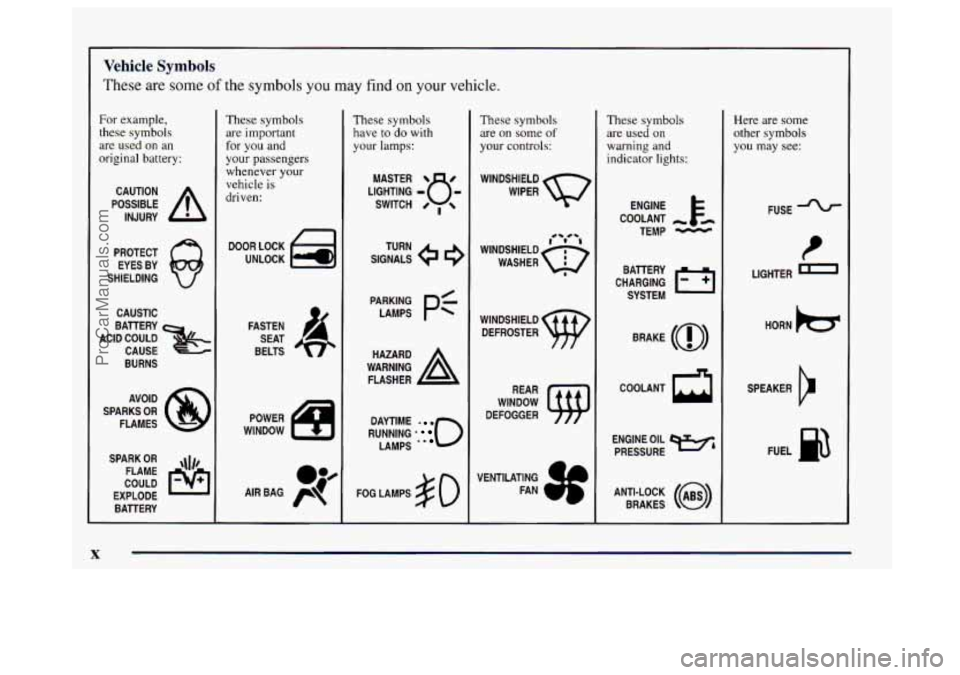
Vehicle Symbols
These are some of the symbols you may find on your vehicle.
For example,
these symbols
are used on an
original battery:
POSSIBLE A
CAUTION
INJURY
PROTECT EYES
BY
SHIELDING
CAUSTIC
BATTERY
CAUSE
BURNS
ACID COULD
&
AVOID
SPARKS
OR
FLAMES
SPARK
OR ,\I/,
COULD FLAME
EXPLODE BATTERY
. K
These symbols
are important
for you and
your passengers
whenever your
vehicle is
driven:
DOOR LOCK
UNLOCK
FASTEN SEAT
BELTS
These symbols have to do with
your lamps:
SIGNALS e
TURN
WARNING
A
HAZARD
FLASHER
RUNNING
' 0
DAYTIME rn
LAMPS .*
FOG LAMPS $0
These symbols
are on some
of
your controls:
WINDSHIELD
WIPER
WINDSHIELD DEFROSTER
WINDOW
DEFOGGER
These symbols are used
on
warning and
indicator lights:
ENGINE t
COOLANT - tm
TEMP -
CHARGING I-1
BATTERY
SYSTEM
BRAKE
(0)
COOLANT a
ENGINE OIL e,
PRESSURE
ANTI-LOCK
(@)
BRAKES
1
Here are some
other symbols
you may see:
FUSE
t
LIGHTER
HORN
)cr
SPEAKER
b
FUEL p3
ProCarManuals.com
Page 77 of 406

Section 2 Features and Controls
Here you can learn about the many standard and optional features on your Buick, and information on starting, shifting
and braking. Also explained are the instrument panel and the warning systems that tell you
if everything is working
properly
-- and what to do if you have a problem.
2-2
2-4
2-9
2- 14
2-15
2-16 2-17
2-17
2- 19
2-20
3-22
2-26
2-27
2-29
2-30
2-30
2-3 1
Keys
Door Locks
Remote Keyless Entry TrUnk
Theft
PASS-Key@ I1
New Vehicle “Break-In”
Ignition Positions Starting Your Engine
Engine Coolant Heater
Automatic Transaxle Operation
Parking Brake
Shifting Into PARK
(P)
Shifting Out of PARK (P)
Parking Over Things That Burn
Engine Exhaust
Running Your Engine While
You’re Parked 2-32
2-33
2-33
2-34
2-4 1
2-44
2-46
2-49
2-50
2-50
2-5 1.
2-52
2-52
2-53
2-54
2-55 Windows
Horn
Tilt Steering Wheel
Turn SignalMultifunction Lever
Exterior Lamps
Interior Lamps
Mirrors
Storage Compartments
Ashtrays and Lighter
Sun Visors
Auxiliary Power Connection
Sunroof
Cellular Phone Provisions
Instrument Panel
-- Your Information System
Instrument Panel Cluster
Warning Lights, Gages and Indicators
2-1
ProCarManuals.com
Page 94 of 406
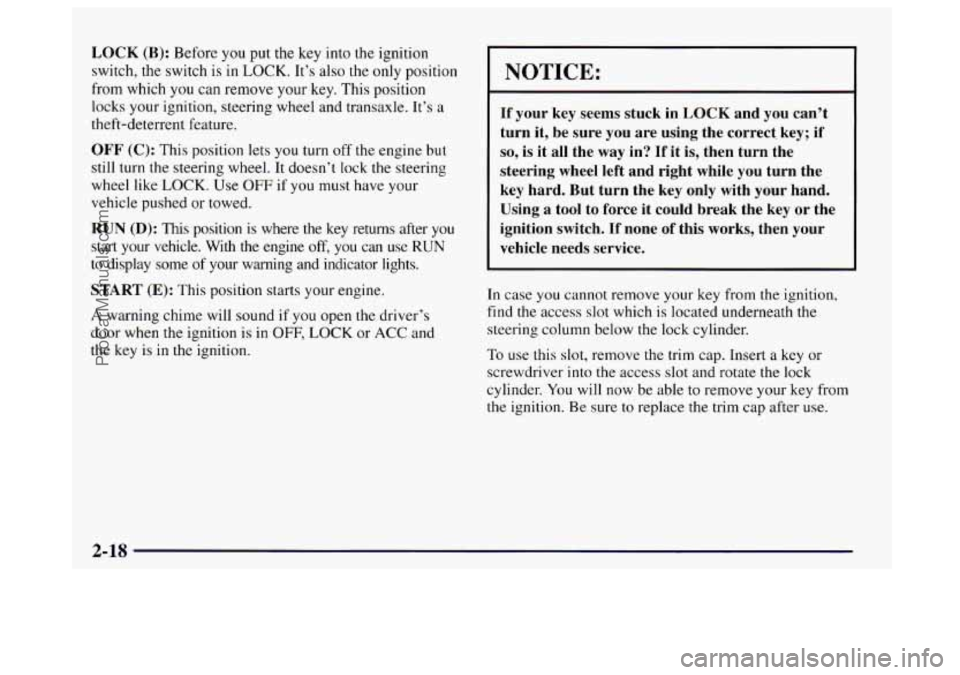
LOCK (B): Before you put the key into the ignition
switch, the switch is in
LOCK. It’s also the only position
from which you
can remove your key. This position
locks your ignition, steering wheel and transaxle. It’s
a
theft-deterrent feature.
OFF (C): This position lets you turn off the engine but
still turn
the steering wheel, It doesn’t lock the steering
wheel like
LOCK. Use OFF if you must have your
vehicle pushed or towed.
RUN (D): This position is where the key returns after you
start your vehicle. With the engine off, you can use RUN
to display some of your warning and indicator lights.
START (E): This position starts your engine.
A warning chime will sound if you open the driver’s
door when the ignition is
in OFF, LOCK or ACC and
the key is in the ignition.
NOTICE:
If your key seems stuck in LOCK and you can’t
turn it, be sure you are using the correct. key; if
so, is it all the way in? If it is, then turn the
steering wheel left and right while you turn the
key hard. But turn the key only with your hand.
Using a tool to force it
could break the key or the
ignition switch.
If none of this works, then your
vehicle needs service.
In case you cannot remove
your key from the ignition,
find the access
slot which is located underneath the
steering column below the lock cylinder.
To use this slot, remove the trim cap. Insert
a key or
screwdriver into the access slot and rotate the lock
cylinder.
You will now be able to remove your key from
the ignition. Be sure to replace the trim cap after use.
2-18
ProCarManuals.com
Page 131 of 406
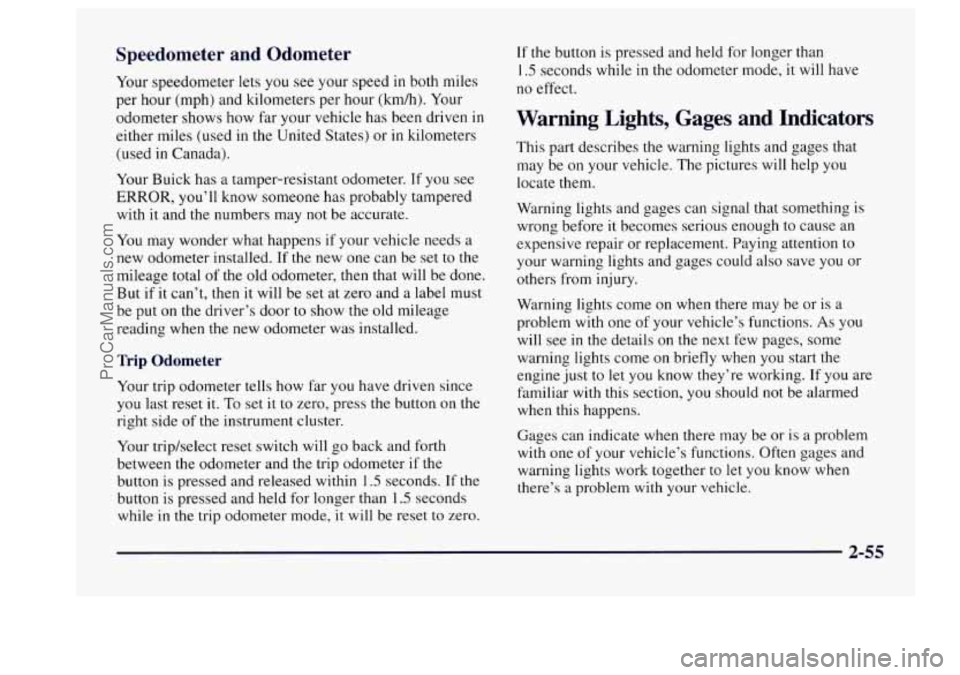
Speedometer and Odometer
Your speedometer lets you see your speed in both miles
per hour (mph) and kilometers per hour (kdh). Your
odometer shows how far your vehicle has been driven
in
either miles (used in the United States) or in kilometers
(used
in Canada).
Your Buick has a tamper-resistant odometer.
If you see
ERROR, you’ll know someone has probably tampered
with it and the numbers may not be accurate.
You may wonder what happens if your vehicle needs a
new odometer installed. If the new one can be set to the
mileage total of the old odometer, then that will be done.
But if it can’t, then
it will be set at zero and a label must
be put on the driver’s door
to show the old mileage
reading when the new odometer was installed.
Trip Odometer
Your trip odometer tells how far you have driven since
you last reset it. To set it to zero, press the button on the
right side of the instrument cluster.
Your triphelect reset switch will go back and forth
between the odometer and the trip odometer if the
button
is pressed and released within 1.5 seconds. If the
button is pressed and held for longer than
1.5 seconds
while in the trip odometer mode, it will be reset to zero.
If the button is pressed and held for longer than
I .5 seconds while in the odometer mode, it will have
no effect.
Warning Lights, Gages and Indicators
This part describes the warning lights and gages that
may be on your vehicle. The pictures will help you
locate them.
Warning lights and gages can signal that something is
wrong before it becomes serious enough to cause an
expensive repair or replacement. Paying attention to
your warning lights and gages could also save
you or
others from injury.
Warning lights come on when there may be or
is a
problem with one
of your vehicle’s functions. As you
will see in the details on the next few pages, some
warning lights come on briefly when
you start the
engine just to
let you know they’re working. If you are
familiar with this section, you should not be alarmed
when this happens.
Gages can indicate when there may be or is a problem
with one of your vehicle’s functions. Often gages and
warning lights work together to let you know when
there’s a problem with your vehicle.
2-55
ProCarManuals.com
Page 132 of 406
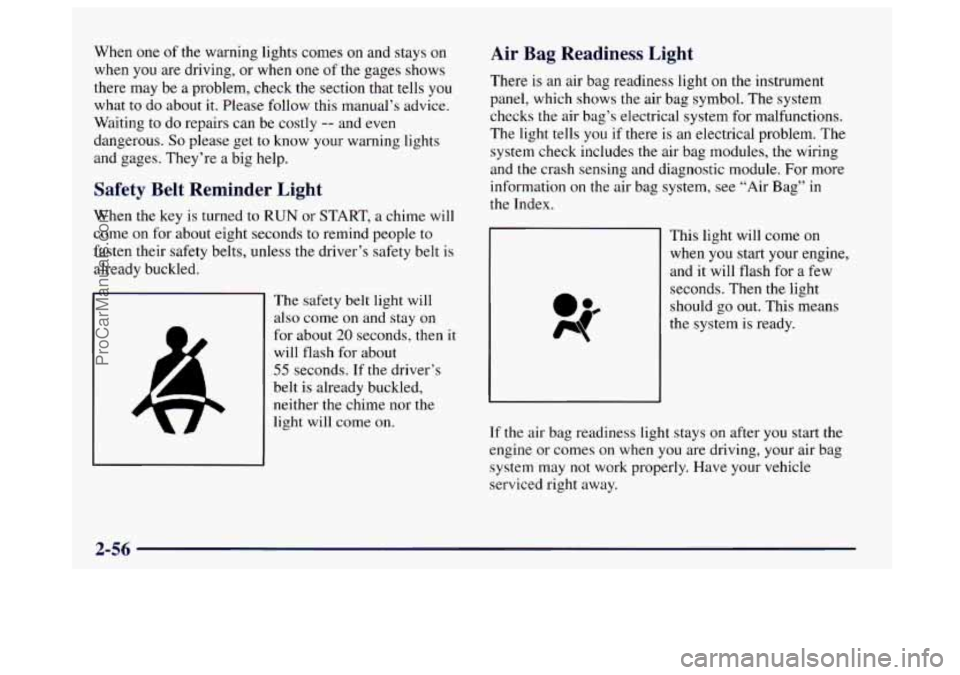
When one of the warning lights comes on and stays on
when
you are driving, or when one of the gages shows
there may be a problem, check the section that tells you
what to do about
it. Please follow this manual’s advice.
Waiting
to do repairs can be costly -- and even
dangerous.
So please get to know your warning lights
and gages. They’re a big help.
Safety Belt Reminder Light
When the key is turned to RUN or START, a chime will
come on for about eight seconds to remind people to
fasten their safety belts, unless the driver’s safety belt
is
already buckled.
The safety belt light will
also come on and stay on
for about
20 seconds, then it
will flash for about
55 seconds. If the driver’s
belt is already buckled,
neither the chime nor the
light
will come on.
Air Bag Readiness Light
There is an air bag readiness light on the instrument
panel, which shows the air bag symbol. The system
checks the air bag’s electrical system for malfunctions.
The light tells you if there is an electrical problem. The
system check includes the air bag modules, the wiring
and the crash sensing and diagnostic module. For more
information
on the air bag system, see “Air Bag” in
the Index.
This right will come on
when you start your engine,
and it will flash for a few
seconds. Then the light
should
go out. This means
the system is ready.
If the air bag readiness light stays
on after you start the
engine or comes on when
you are driving, your air bag
system may not work properly. Have your vehicle
serviced right away.
2-56
ProCarManuals.com
Page 286 of 406
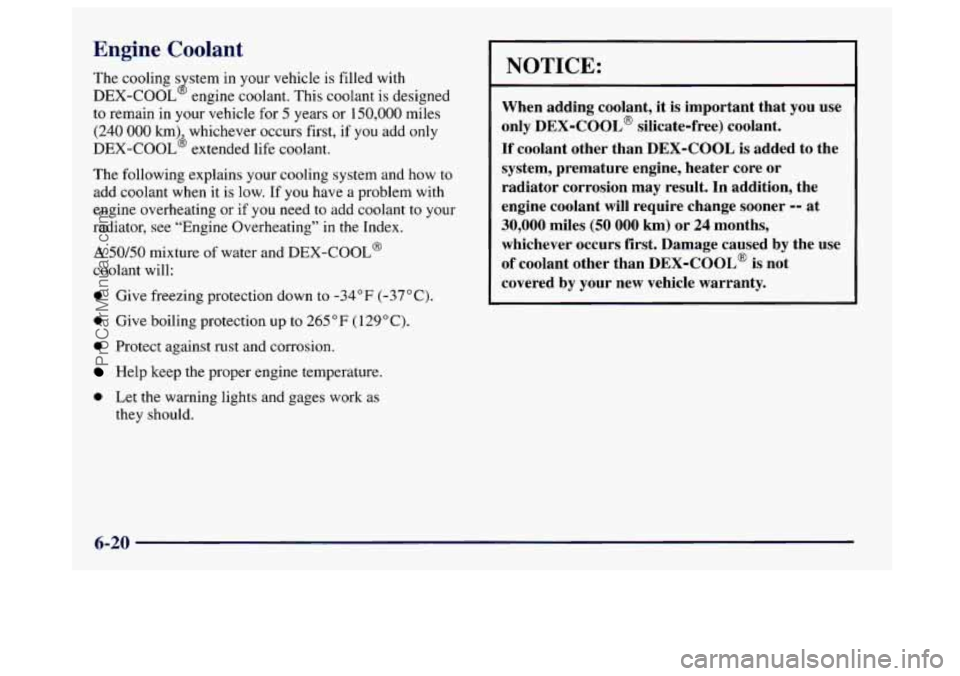
Engine Coolant
The cooling s stem in your vehicle is filled with
DEX-COOL engine coolant. This coolant is designed
to remain in your vehicle for
5 years or 150,000 miles
(240 000 km) whichever occurs first, if you add only
DEX-COOL’ extended life coolant.
J
The following explains your cooling system and how to
add coolant when it is low.
If you have a problem with
engine overheating or if you need to add coolant to your
radiator, see “Engine Overheating”
in the Index.
A 50/50 mixture of water and DEX-COOL@
coolant will:
0 Give freezing protection down to -34°F (-37°C).
0 Give boiling protection up to 265 OF ( 129 O C).
0 Protect against rust and corrosion.
Help keep the proper engine temperature.
0 Let the warning lights and gages work as
they should.
NOTICE:
When adding coolant, it is important that you use
only
DEX-COOL@ silicate-free) coolant.
If coolant other than DEX-COOL is added to the
system, premature engine, heater core or radiator corrosion may result. In addition, the
engine coolant will require change sooner
-- at
30,000 miles (50 000 km) or 24 months,
whichever occurs first. Damage caused by the use
of coolant other than DEX-COOL@ is not
covered
by your new vehicle warranty.
6-20
ProCarManuals.com
Page 398 of 406
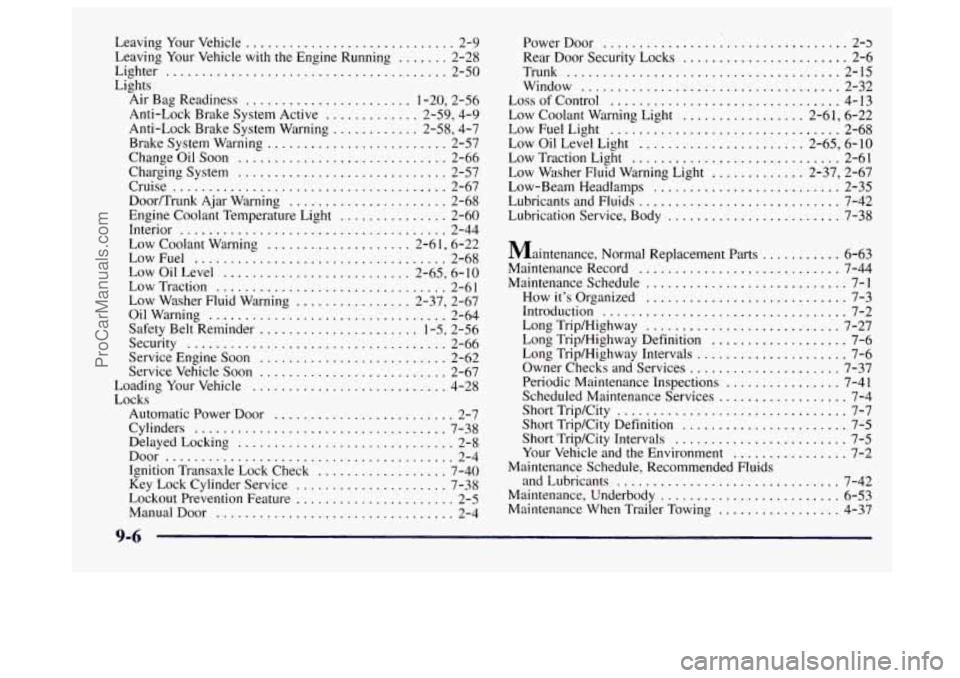
Leaving Your Vehicle ............................. 2-9
Leaving Your Vehicle with the Engine Running
....... 2-28
Lighter
....................................... 2-50
Lights Air Bag Readiness
....................... 1-20’2-56
Anti-Lock Brake System Active
............. 2-59, 4-9
Anti-Lock Brake System Warning
............ 2-58, 4-7
Brake System Warning
......................... 2-57
Change Oil Soon
............................. 2-66
Charging System
............................. 2-57
Door/Trunk Ajar Warning
...................... 2-68
Engine Coolant Temperature Light
............... 2-60
Interior
..................................... 2-44
Low Coolant Warning
.................... 2-61, 6-22
LowFuel
................................... 2-68
Low Oil Level
.......................... 2-65, 6- 10
Low Traction ................................ 2-6 1
Low Washer Fluid Warning ................ 2-37, 2-67
Oilwarning
................................. 2-64
Safety Belt Reminder
...................... 1-5, 2-56
Security
.................................... 2-66
Service Engine Soon
.......................... 2-62
Service Vehicle Soon
.......................... 2-67
Loading Your Vehicle
........................... 4-28
Cylinders
................................... 7-38
Delayed Locking
.............................. 2-8
Cruise
...................................... 2-67
Locks Automatic Power Door
......................... 2-7
Door
........................................ 2-4
Ignition Transaxle Lock Check
.................. 7-40
Key Lock Cylinder Service
..................... 7-38
Lockout Prevention Feature
...................... 2-5
ManualDoor
................................. 2-4 PowerDoor
.................................. 2-3
Rear Door Security Locks ....................... 2-6
Trunk
...................................... 2-15
Window
..................................... 2-32
Loss of Control
................................ 4-13
Low Coolant Warning Light
................. 2-61, 6-22
Low Oil Level Light
....................... 2-65, 6-10
Low Traction Light ............................. 2-61
Low Washer Fluid Warning Light ............. 2-37, 2-67
Low-Beam Headlamps
.......................... 2-35
Lubricants
and Fluids ............................ 7-42
Lubrication Service, Body
........................ 7-38
LowFuelLight
................................ 2-68
Maintenance, Normal Replacement Parts
........... 6-63
Maintenance Record ............................ 7-44
How it’s Organized
............................ 7-3
Long Trip/Highway
........................... 7-27
Long Trip/Highway Definition
................... 7-6
Long Tripmighway Intervals ..................... 7-6
Owner Checks and Services
..................... 7-37
Periodic Maintenance Inspections
................ 7-41
Scheduled Maintenance Services
.................. 7-4
Short Trip/City
................................ 7-7
Short Trip/City Definition
....................... 7-5
Short Trip/City Intervals
........................ 7-5
Your Vehicle and the Environment
................ 7-2
and Lubricants ............................... 7-42
Maintenance, Underbody
......................... 6-53
Maintenance When Trailer Towing
................. 4-37
Maintenance Schedule
............................ 7-1
Introduction
.................................. 7-2
Maintenance Schedule, Recommended Fluids
9-6
ProCarManuals.com
Page 403 of 406

TTYUsers ..................................... 8-4
Turn Signal and Lane Change Indicator
............. 2-34
Turn Signal On Chime
........................... 2-35
Turn Signal/Multifunction Lever
................... 2-34
Turn Signals When Towing a Trailer
................ 4-36
Twilight Sentinel
............................... 2-43
Two-way Manual Seat
........................... 1-2
Underbody Flushing Service
..................... 7-40
Underbody Maintenance
......................... 6-53
Underhood Electrical Center (Passenger’s Side)
....... 6-60
Vehicle Control
...................................... 4-6
Damage Warnings
.............................. ix
Dimensions ................................. 6-63
Identification Number
......................... 6-55
Loading
.................................... 4-28
Storage
..................................... 6-30
Symbols
....................................... x
Ventilation System .............................. 3- 10
Visor Vanity Mirrors ............................ 2-5 1
Visors. Sun .................................... 2-50 warning
Devices
............................... 5-2
Warranty Information
............................. 8-8
Washing Your Vehicle ........................... 6-50
Weatherstrips
.................................. 6-50
Wheel Alignment
.................................. 6-43
Nut Torque ............................. 5-34. 6-62
Replacement
................................. 6-43
Used Replacement
............................ 6-44
Window Lock
.................................. 2-32
Windows
..................................... 2-32
Auto-Down
................................. 2-32
Power
...................................... 2-32
Windshield Washer
............................. 2-36
Fluid
.................................. 2-37. 6-25
Fluid Level Check
............................ 7-37
Windshield Wipers
.............................. 2-36
Blade Replacement
........................... 6-36
Fuses
...................................... 6-56
Winter Driving
................................. 4-24
Wiper Blade Check
............................. 7-38
Wiring. Headlamp
.............................. 6-56
WreckerTowing
................................. 5-9
Warning Lights. Gages and Indicators ............... 2-55
Your Driving and the Road
....................... 4-1
9-11
ProCarManuals.com